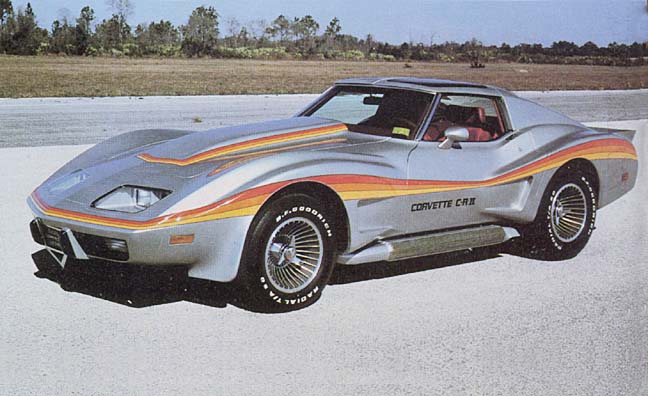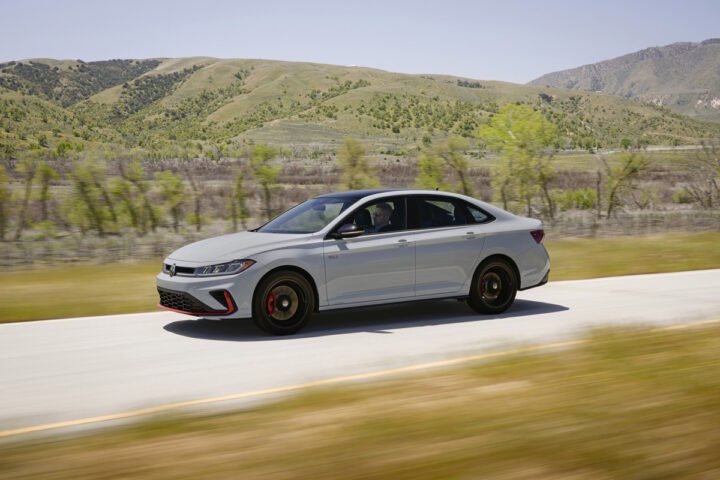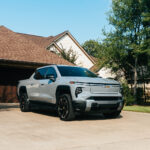 by Mike Guyette
by Mike Guyette
Generically referred to as the “CanAm” body style, Eckler’s design somewhat resembled a cross between the Greenwood Sebring GT and Turbo GT. This new widebody by Eckler’s was actually called the “CR-II Series”, the “CR” meaning Café Racer, a term taken from modified, high-performance European sports cars that would race from one café to another. To this day many mistakes the Eckler’s CR-II series for Greenwood cars, and hence, the reason for this section being included in the Greenwood Corvettes website.
There are a few ways to distinguish an Eckler’s CanAm from a Greenwood widebodied car, typically in respect to the fenders. The CanAm front fenders are more horizontally pronounced, jutting almost straight out from the stock fender lines. This is particularly noticeable from the front view. The Greenwoods integrated their wider fenders a bit more subtly. The front fenders of the CanAm also sported a single vent, not unlike the stock vent of the rubber bumper Sharks. The Greenwood Sebring GT sported a single protruding vent while the Turbo GT used a vertical five-slot arrangement. All Greenwood widebody streetcars also had the rear of the front fenders open for the relief of pent-up pressure and heat. The CanAm’s front fenders merged back to the stock door width, eliminating the open rear and need for a complete door cap.
The rear fenders of the CanAm followed the form of the fronts in that they too jut out from the stock fender line. Most no
ticeable is the simulated vent on the leading edge of the rear fenders, which is almost a mirror image of the front fender’s vent. Actually molded into a separate piece, this non-functional scoop attaches to the door. In some cases, these pseudo-vents were filled in, lending a smoother, custom look to the CanAm’s fenders.
Just as American Custom Industries built and sold kits and complete cars based on Greenwood designed body panels, so too did Eckler’s. They also followed suit with their own Can Ams, building several cars for customers in their Titusville facility. The CR-II Series (I’m not sure if there was a Series I) had several options available according to their 1979 and 1980 catalogs. In these are listed front and rear wheel wells, rear bumpers, a rear spoiler, and even a hatchback conversion.
Eckler’s primary products were fiberglass back then so it’s no wonder that they made just about every conceivable body panel and clip, both stock and custom, for all years of Corvettes. Bob and Ralph had all the bases covered by offering their CR-II series as individual fenders and also as complete rear clips. Rear fenders were offered in 10″ and 12″ widths, and triple taillight rear bumpers to match these fenders. In many cases the triple taillight bumpers were not ordered, retaining the stock bumper. In doing so, the back of the rear fenders was usually left open, resembling the Greenwood racing and street fenders of the ’70s.
Like the Sportwagon and Panelwagon options offered by Eckler’s, their Hatchback kits could be ordered as a graft-on, upper rear section, or as a complete rear clip – with or without rear flares. ACI also provided a hatchback conversion, but Greenwood never did. Another popular item and often used in conjunction with the Can-Am kits is the recessed quad headlamps conversion, also offered by Eckler’s. The options were myriad and as a result, many combinations of custom Corvettes could be constructed from Eckler’s parts catalog, ensuring some semblance of exclusivity.
I have seen both Sport and Panel wagon in combination with CanAm fenders, Turbo front fenders with CanAm rears, and various wings and spoilers united to Hatchbacks and Sportwagon. On top of the conjoining of differing body panels, some body shops and individuals would also go to great lengths to incorporate their own styling cues, ending up with some unique Corvettes.
 The Eckler’s Can-Am style was extremely popular and didn’t go unnoticed in the eyes of the model makers. At least two model kits were made by AMT, and I believe a small diecast was produced by Matchbox.
The Eckler’s Can-Am style was extremely popular and didn’t go unnoticed in the eyes of the model makers. At least two model kits were made by AMT, and I believe a small diecast was produced by Matchbox.
The Eckler’s CR-II Series body kits, like most of the Greenwood kits of the ’70s and ’80s, are no longer available, the molds having been destroyed long ago. To the purists, these Corvettes (or any deviation from original, for that matter) are an abomination. I would like to think of the Eckler’s, ACI and Greenwood designs as a slice of history that won’t soon be replicated, and is truly missed by some. A time when polyester leisure suits, platform shoes, and disco music were all the rage. So too were the Café Racer styles and psychedelic paint schemes of those outrageous widebody Corvettes.






















